When you were a kid, chances are your mom told you not to eat anything you found on the ground. Time passes and now that you are grown up and visiting the Fruit and Spice Park in Homestead, you are actually encouraged to do just that.
Yes, you are urged to eat any fruit you find on the ground, as long as you know it’s edible before biting into it. And don’t worry, the trees are not spayed with pesticides.

We lucked out and being big mango fans, we visited in mango season when we were able to try over 14 different varieties before we were too full to try more.
You can bet that’s part of the reason the 37-acre park welcomes 50,000 visitors a year to see 500 varieties of exotic fruits, herbs, spices and nuts from around the world. That includes over 150 varieties of mangos making the park the largest public collection of different mango trees in the United States.
Even without discovering fruit on the ground along the way, you will be offered a sample of one or two pieces of fruit to taste in the visitor center.
Redland International Orchid Festival, May 17-19, 2024
This event takes place at Fruit and Spice Park and features some of the top orchid growers in the world. It is one of the oldest, largest and most prestigious orchid events in the country. It includes live music and food. Best deal is to buy tickets in advance; tickets include admission to the park.
What else is special about the Fruit and Spice Park?
The Fruit and Spice Park, in the preeminent agricultural area of the Redland, is said to be the only garden of its kind in the contiguous United States. That is, in part, because its subtropical climate is found nowhere else in the continental U.S.
That means there are fruit trees that flourish here that you can’t see anywhere else in the 48 states.
And the park is special because it’s in the Redland, known for and named after its red clay soil. That soil rests on a layer of oolitic limestone. The layer developed when the sea covered this part of Florida and caused the shells of marine life to calcify.
Along with water from the Biscayne Aquifer, there’s plenty to quench and nourish the park’s bounty.
That allows the park to be home to 70 varieties of bamboo, 50 kinds of avocados and 15 varieties of jackfruit trees. And be sure to see the 40 different types of bananas that, like the park’s mango collection, forms the largest collection in the contiguous United States.
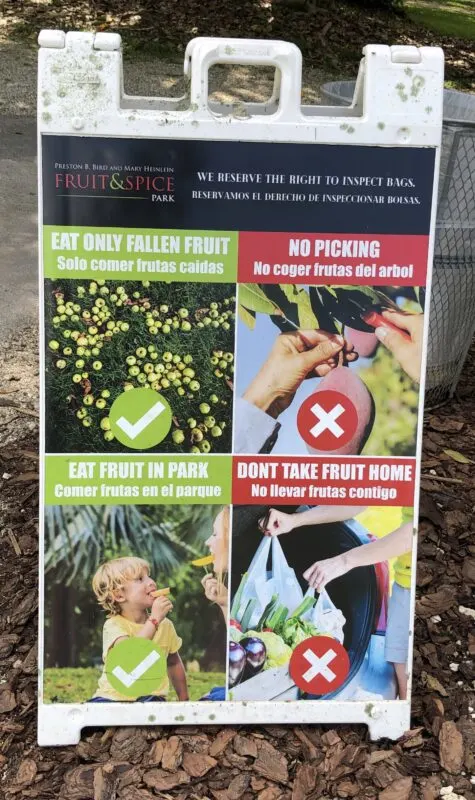
Rambler Tip: The Fruit and Spice Park is fun because it allows you to sample fruits you find ripe and on the ground. We didn’t mind just picking them up, brushing off the sand and taking a bite. (We didn’t even mind the mango skins because we aren’t allergic to them.)
However, if you want to be a bit more refined, you might bring a bottle of water for washing the fruit and a small pocket knife for trimming it. You also may want to throw some packages of moist towelettes into your bag to take care of sticky fingers.
Who planted the seed for the Fruit and Spice Park?
Little did Mary Calkins Heinlein realize what her dream would lead to when she set to making it a reality in the mid-1900s.
The descendant of pioneer homesteaders, Heinlein wanted to create a public garden that showcased the avocados, mangoes, sapodillas, papayas, lemons and limes the locals were growing.
In 1935, she worked with the city commissioners and Parks Director A.D. Barnes to purchase 18 acres of land. By 1943, the purchase had been made with the help of commissioner Preston B. Byrd.
The next step was to contact Lyman Philips. He’s the landscape architect who had created the Fairchild Tropical Botanic Garden.
He finished his plans for the Fruit and Spice Park in 1944; ground was broken that same year. That’s when Heinlein and her husband with a team of laborers and park workers laid out the planned plots where they planted collected specimens. The collection grew and soon a variety of rare fruits, nuts and spices flourished.
When the park was completed, Heinlein was named the first superintendent, a position she held until her retirement in 1959.
In 1980, the park was officially named the Preston B. Bird & May Heinlein Fruit and Spice Park, but today it is referred to as the Fruit and Spice Park.
Hurricanes and history at the Fruit and Spice Park
Arrive at the park and you are welcomed in a re-creation of the Redland Schoolhouse. The original had been built in 1906 of virtually indestructible Dade County pine to house grades one through 12.
It was closed in 1916 but got new life in the 1940s when it was relocated to the nearby Fruit and Spice Park.
Here, it served as the entrance to the park until Hurricane Andrew destroyed it in 1992. Using FEMA funds, it was reconstructed and reopened as the park’s Welcome Center in 2002.
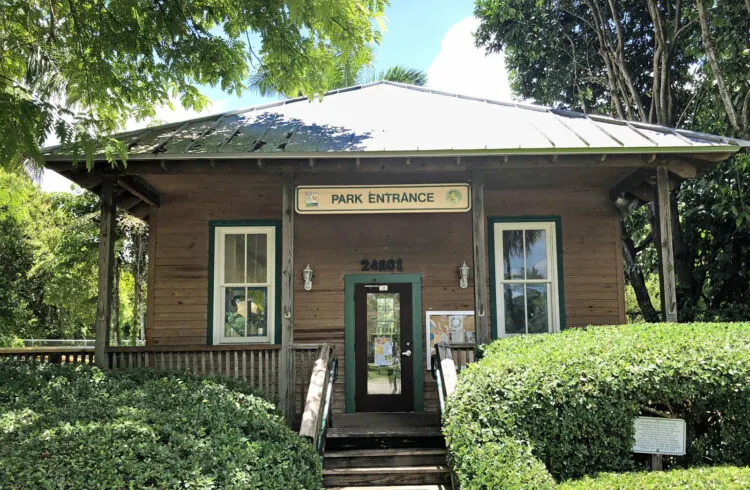
Hurricane Andrew did more damage to the park than just knocking down the schoolhouse. In fact, it took down everything: all the trees, shrubs, vines, planting beds, irrigation system, fencing and the nursery.
Virtually all you see today is relatively new.
10 wonders of the Fruit and Spice Park
Here are what we found to be the most interesting, delicious and/or strange plants at the Fruit and Spice Park.
1. African Sausage tree
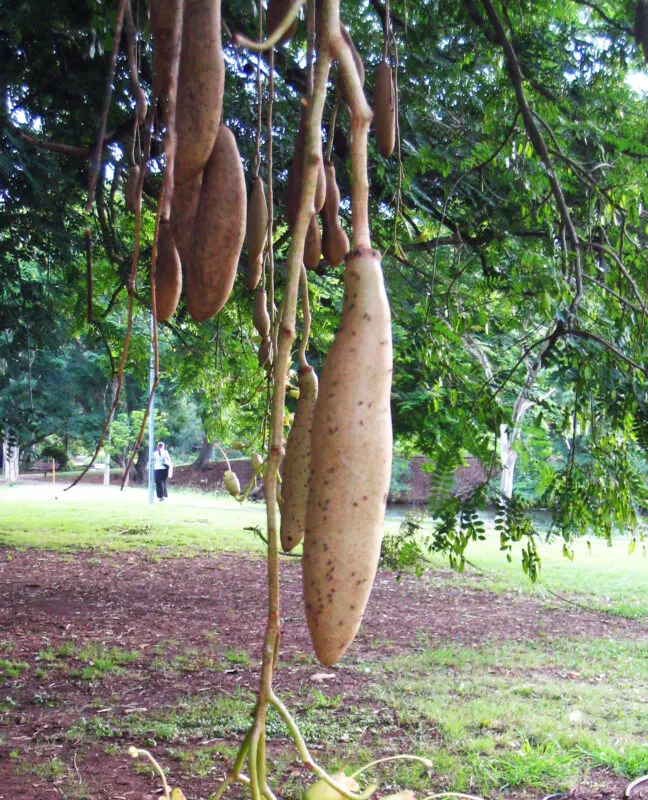
Although you shouldn’t eat these poisonous fruits, they can grow to 25 feet long and look like sausages in casings hanging from the tree.
To eat them, you would need to ferment, dry or roast the ripe fruit.
On the other hand, the young green fruits can be mashed into a paste that has anti-bacterial properties similar to Neosporin.
2. Annonas
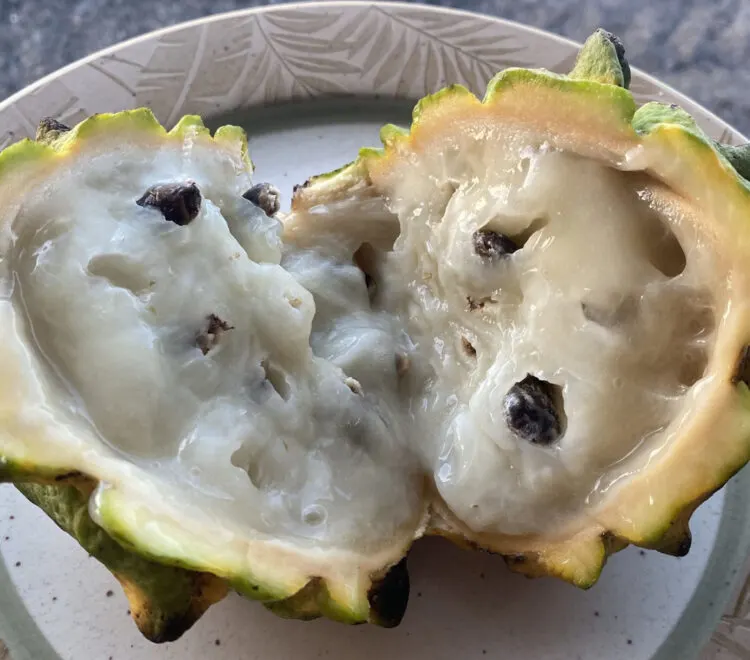
The are 40 varieties of annonas at the park but don’t eat their seeds. They contain neurotoxins that will send you to the hospital.
The one we found most interesting is the Rollinia deliciosa. Its fruit is said to taste like lemon meringue pie. We are sorry we didn’t get to sample one.
3. Bangar Nut
As you take the tram or walk around the park, you may smell the Bangar Nut tree before you see its showy red fruits. The smell is like that of mothballs. The odor deters pests and comes from the leaves and fruit of the tree.
The tree’s scientific name Sterculia foetida comes from the name of the Roman god of manure and the word for foul smelling. Although its nuts are edible if you roast them, too many of them will still upset your stomach.
Another reason not to plant this tree is that its trunk is riddled with holes that tend to fill with water that attracts mosquitoes for breeding.
4. Baobab
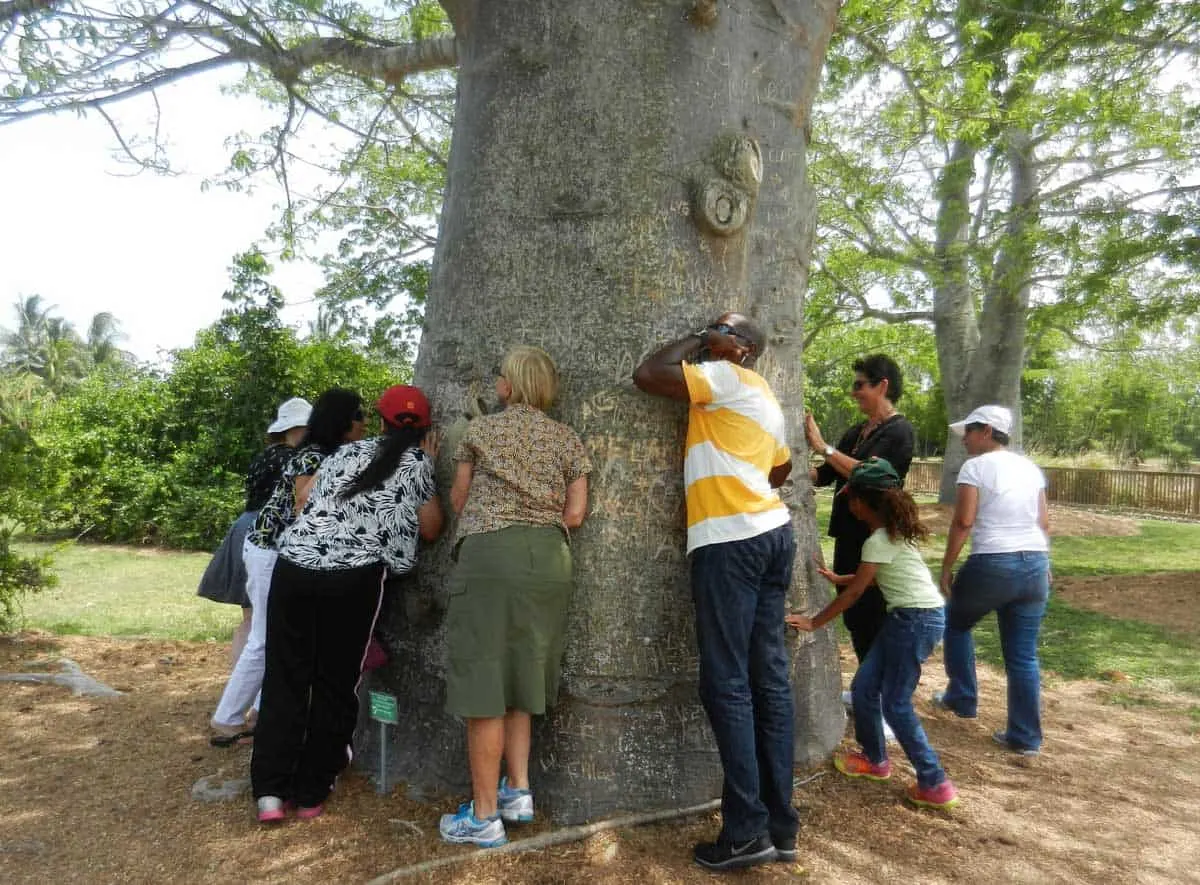
After Hurricane Andrew, we are told, the Baobab was the only variety of tree to survive although knocked over and requiring some righting. Today, the park is home to eight of the nine species that exist worldwide.
The oldest Baobab tree you’ll see at the park is 85 years old. But in their native lands of Africa and Madagascar, these trees have been known to live over 1,200 years and reach the size of a stadium.
Often called the Tree of Life, its soft trunk can measure 30-feet in diameter and this is where the tree stores water. Elephants are known to scratch the trunk to release it. People bore holes in the trees and pull out their wet woody fiber. It can be squeezed to extract the liquid.
As the tree grows, its trunk hollows out making a cave-like room for those who need shelter. Plus, the tree’s young leaves can be eaten as can its fruit.
5. Candle Nut tree

The state tree of Hawaii, it gets its name from the nut inside its walnut-sized fruits. The nut is covered with an oil that can burn like a candle for about 15 minutes per nut. Indigenous people tie the dried leaves to the nuts to make timers, clocks and even torches.
6. Cashew Tree
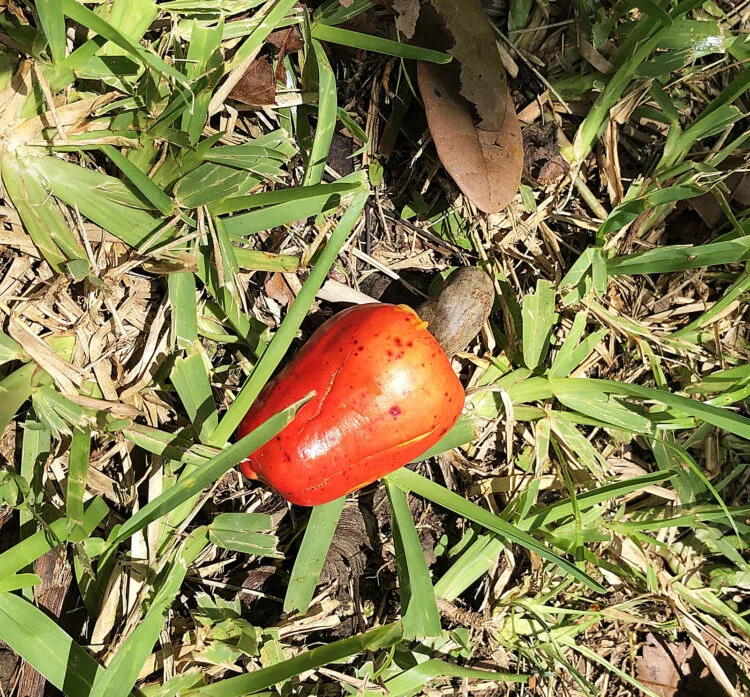
If you’ve wondered where cashew nuts come from, look no further. At the Fruit and Spice Park in season, you can see it growing from what looks like a red or yellow apple.
Although the “apple” is safe to handle and eat, it tastes astringent. Our tour guide described it as “sappy, leaving a film over your tongue and lips.”
On the other hand, a kidney-shaped protuberance that grows at the bottom of the apple is wrapped in a shell that contains the same irritant as poison ivy. So, don’t handle it.
When processed, this is what becomes the cashew nut you know and love. However, there are many steps to make the nuts safe to eat. That is why cashews are some of the most expensive nuts you can find.
7. Gingerbread Nut Palm
This is a palm tree with fruit that tastes like gingerbread and nuts that contain ivory. Vegetable ivory, that is.
Similar to the animal ivory, like that in an elephant’s tusks, it is hard and white and requires files and hacksaws to carve it.
But unlike animal ivory, it develops from the tissue inside the tree’s seeds.
8. Ice Cream Bean tree
This evergreen tree produces large pods that contain seeds surrounded by white pulp. It’s said the fluffy pulp tastes like vanilla ice cream or cotton candy.
9. Rainbow Eucalyptus
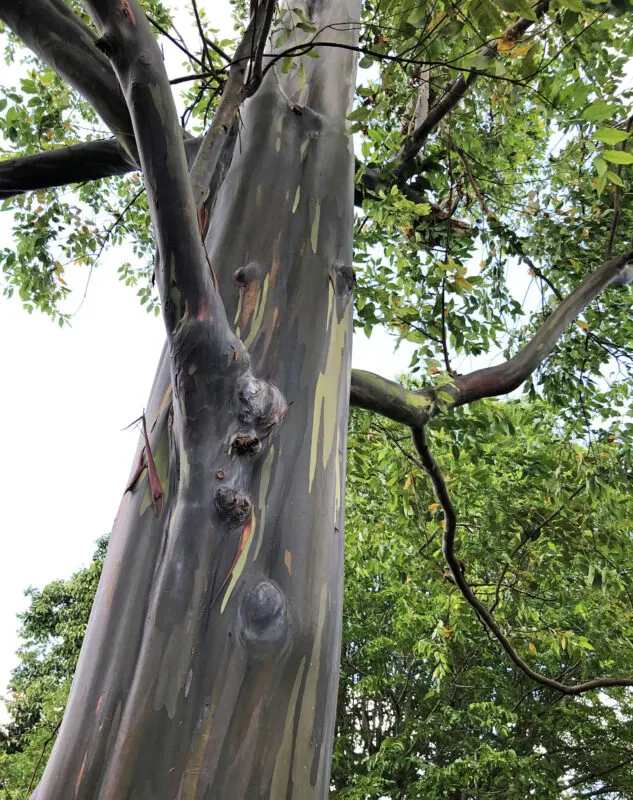
Growing three feet a year, the rainbow eucalyptus can reach almost 250 feet tall. It’s orange-tinted bark peels to expose streaks of pale green, red, orange, grey and purplish brown. The peeling bark helps the tree rid itself of parasites.
10. Lychee trees
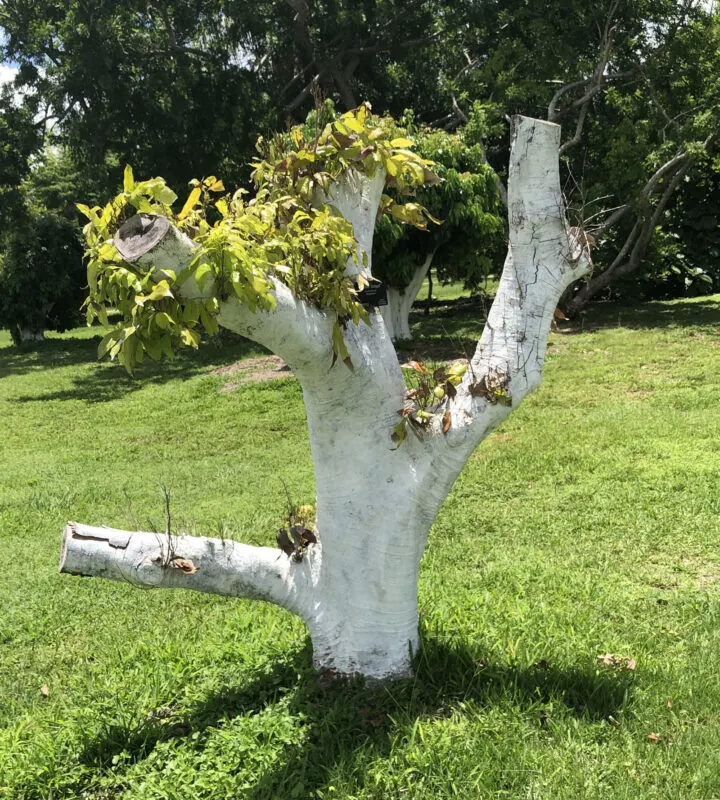
Right now, the lychee trees just may be the saddest looking trees in the Fruit and Spice Park. They’ve been attacked by lychee mites, very small parasitic bugs that destroy the leaves and cause the trees to stop fruiting.
These pests are easily spread by wind, bees and simple migration. Thus many trees many be infested and large areas need to be treated at one time.
The only way to fight the mites without using chemicals is to remove all a tree’s branches and spray the trunk with sulphur every few days. The coating looks like white paint and serves as sun block for the trees denuded of their canopies.
As their canopies regrow, the trees should be mite-free.
Fruit and Spice Park tours
If you visit the park, we highly recommend you take a guided tour, especially if it’s hot or if you have trouble walking.
The tours are conducted on covered tram cars pulled by a tractor that the guides drive. You board the trams just outside the Welcome Center.
The tours last about an hour and 15 minutes and the regular tour is included in the price of admission.
You will cover a good part of the park as the guides describe their favorite trees, tell a little about the history of the park and the uses and benefits of the plants and their fruits. While not in-depth, the talk is designed to hold your interest.
A Specialty Tasting Tour, later in the afternoon, has an additional fee because it includes prepared samples of at least three fruits discussed on the tour.
We took the regular tour. It was helpful in planning our visit on a hot day when walking was a chore; we knew which areas we wanted to return to and explore on foot. With the help of the park map, we could make efficient use of our time and energy in the heat.
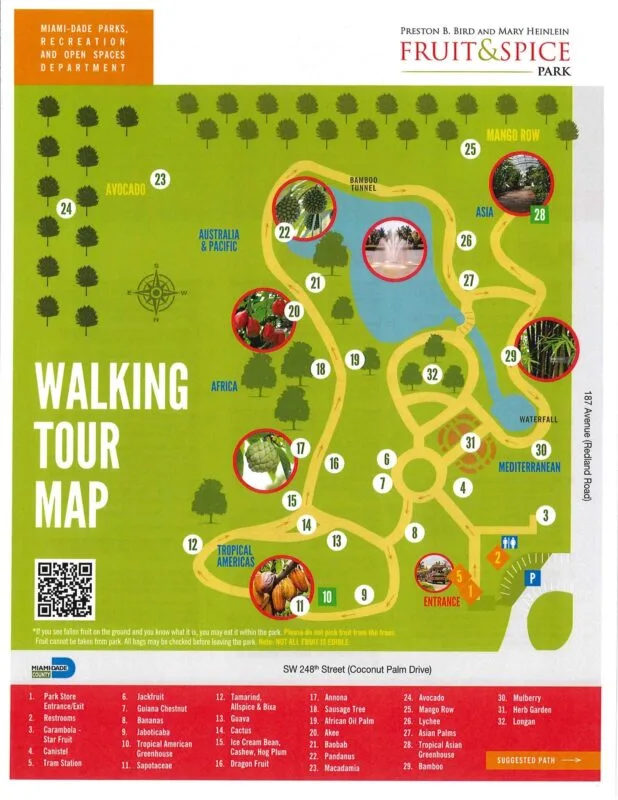
However, the audio system on our tram needed work. It muffled what the guide was saying and you couldn’t understand a word.
When the guide was apprised of the problem, she didn’t get flustered. Instead of using the microphone, she stopped the tram at points of interest, got off the tractor and spoke to us from the ground. Luckily her voice carried well.
This also meant she could hold or point to what she was describing. And it gave us a chance to get off the tram and actually pick up from the ground and taste some of the fruits she was detailing.
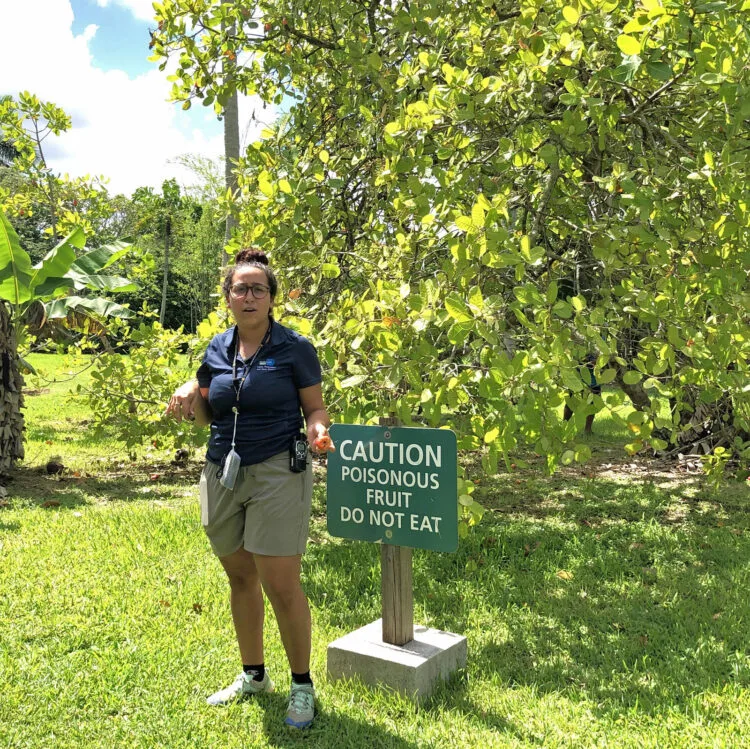
Eating in the Fruit and Spice Park
In case you don’t sample enough fruit to fill you up, you may be looking for a place to eat.
If you look online, you’ll find many websites telling you that the Mango Café on the park grounds is open. However, at this time, it is closed. There is talk of reopening it but no real plans.
Instead, you are welcome to bring a picnic. Tables and benches throughout the park are available.
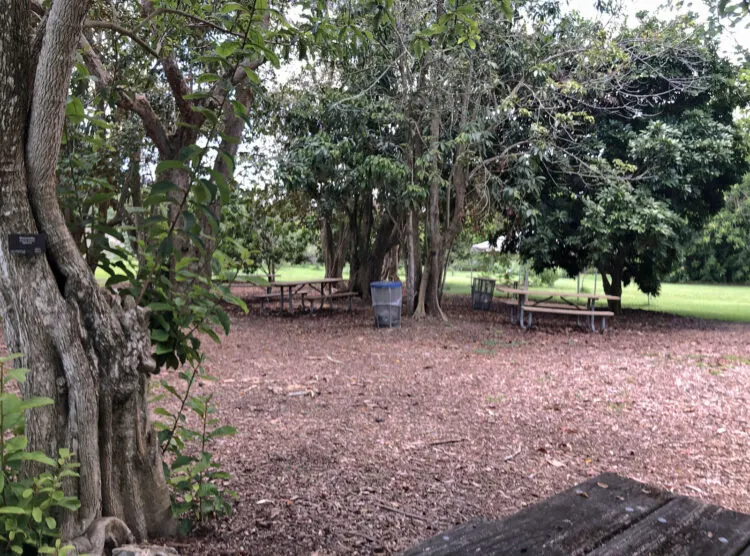
Dining outside the Fruit and Spice Park
There are a number of interesting restaurants in Homestead but we highly recommend Yardie Spice.
It’s owned and run by Rochelle and Jean Paul Cadotte, a Jamaican couple who do the shopping, cooking and serving. They were both in the hospitality business before opening their own place a decade ago. They also operate a nearby fish market they opened two years ago.
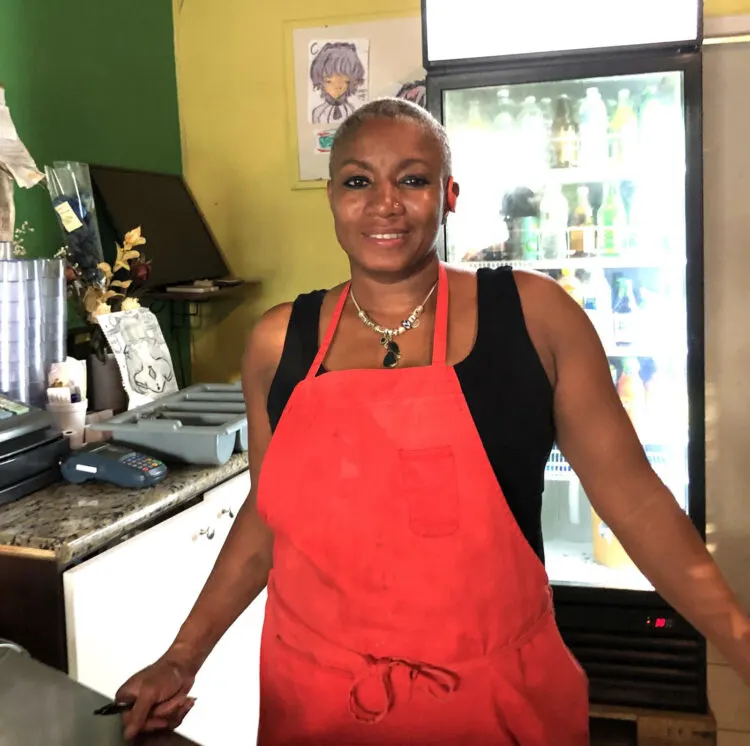
Their street-front restaurant is tiny and much of their business is takeout. Keep that in mind if you want to take lunch to the park.
Or you can eat in at one of the three tables or at one of two counters. If you sit by the cash register, you get to talk to Rochelle as she works. Emanating the friendliness and charm of the islands, she’s happy to help you order her Jamaican and Haitian specialties.
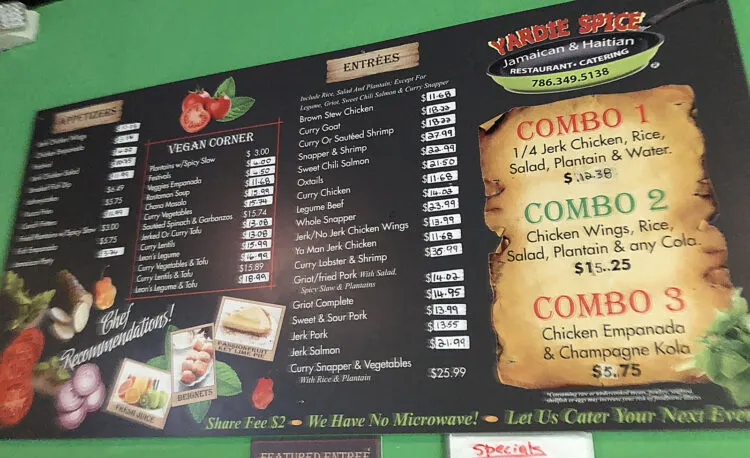
While I was sitting at the counter talking to Rochelle and completely enjoying my evening, a couple entered the dining room. They were visiting from Philadelphia and they, like me, had seen the place written up online.
And, as we ate, we all joined the conversation with Rochelle until dinner was a party.
Here, prices are reasonable; portions generous. We highly recommend the stewed goat!
Sources: Information for this story was supplied, in part, by our tour guide at the Fruit and Spice Park as well as Kevin Lopez, a Park Service Aide, and Andrew Willick, a Guest Service Representative.
If you go
Where: Fruit and Spice Park, 24801 S.W. 187 Ave., Homestead
Parking: Free
Hours: 10 a.m. to 5 p.m. with no admission after 4 p.m.; open seven days a week year-round except Thanksgiving and Christmas Day
Admission: $10, adults; $3, children six through 11; children five and under and members, free
Guided Tours: Tours included with your admission are conducted daily at 11 a.m. and 1:30 p.m., weather permitting. The Specialty Tasting Tour is available at 3 p.m. and is an additional $15. All tours are first come, first served. It’s suggested you arrive 15 minutes before tour times and that you reserve a spot for the tasting tour at 305-247-5727.
What fruit will be ripe when I visit? Here’s a calendar of what is ripe in the garden every month. You can see from this that August, for example, while a hot and humid time for a visit, is when some tasty tropical fruit ripens — carambola, dragon fruit, mamey sapote, passion fruit and others. If you want to buy some of the tropical fruits you see and/or taste, consider also stopping at Robert Is Here, a fun Redland fruit stand 15 minutes away that sells these local produce items and also offers tasting trays of seasonal treats.
More Info: redlandfruitandspice.com; 305-247-5727
When visiting the Fruit and Spice Park in Homestead
Homestead has two national parks and is part of a rural agricultural community called the Redland. There are a number of things to see and do in the area. Here is help from Florida Rambler to plan your visit.
- Everglades National Park: Insider tips for first-time visitors
- Boca Chita Key: Highlight of Biscayne National Park
- Robert Is Here: 6 reasons to stop here on way to Everglades
- A day exploring the Redland: Agriculture and rustic charm thrive near Miami
- Snorkel Biscayne National Park to explore a shipwreck
- Eco-tents in Flamingo: Glamping in Everglades National Park
- Coral Castle: 15 things to amaze you at mysterious ‘work of art’ Homestead
- Knaus Berry Farm: Cinnamon rolls that folks line up for
- Free tours of R F Orchids in Homestead are a must for orchid lovers
From Florida Rambler: Find more beauty spots in Florida’s 20 spectacular botanic gardens

Deborah Hartz-Seeley is a Master Gardener whose yard is certified as Florida Friendly. With a master’s degree in agricultural journalism, she’s written for the Sun-Sentinel, Miami Herald, The Coastal Star, Cook’s Magazine, Florida Food & Farm and Florida Design. If she’s not out back growing things, you’ll find her wandering a garden path or exploring nature on foot, on a bike or in a kayak.

Alan
Sunday 18th of February 2024
Very informative article. I can’t wait to visit the Fruit and Spice Park as well as the whole area.
Jack Farley
Thursday 20th of July 2023
Thank you Deborah. Your article on the Fruit and Spice park is so well researched and written in such an organized and interesting way that I want to get in the car and drive there right now. It is great that someone with such great writing skills has given us this peak into this tropical paradise.